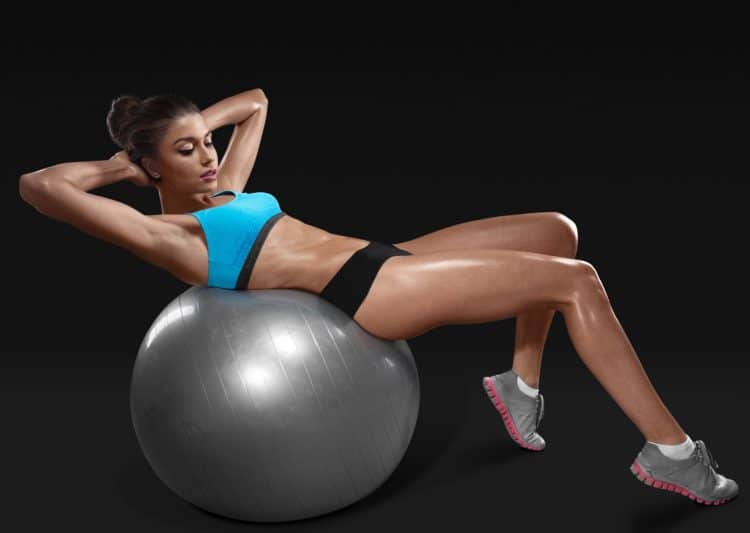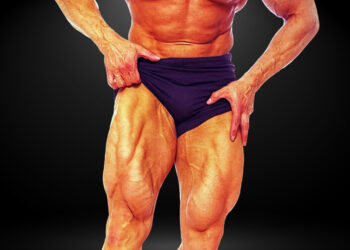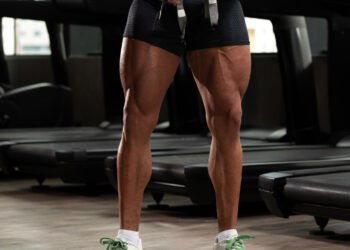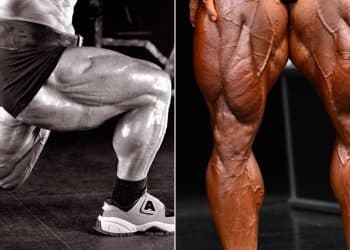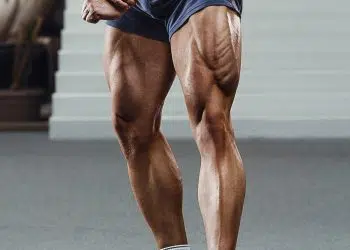Friends don’t let friends skip leg day. And yet, a lot of lifters have underdeveloped legs. In a lot of cases, the cause of this problem is that many bodybuilding splits feature just one lower body training day per week. That may not be enough volume to build bigger leg muscles. Most lifters would benefit from two leg workouts per week.
Save yourself an extra trip to the gym with our tried-and-tested Swiss ball leg workout. Alternately, do this workout any time you can’t make it to the gym, so you don’t miss leg day. It’s also a tremendous low-tech leg workout for home and garage gym trainers.
Swiss Ball Leg Workout
Do this workout once a week to complement your existing leg program. Alternatively, you can do it twice on non-consecutive days, e.g., Monday and Thursday, if you don’t do any other lower body training.
But, before you start, make sure you prepare your joints and muscles with a thorough warm-up. Do 5-10 minutes of easy cardio followed by some dynamic mobility and flexibility exercises for your lower back, hips, knees, and ankles. This will enhance your workout and could reduce your risk of injury.
| Swiss Ball Leg Workout | ||||
| No. | Exercise | Sets | Reps | Recovery |
| 1 | Swiss ball goblet squat | 2-4 | 12-20 | 60-90 seconds |
| 2 | Swiss ball leg curl | 2-4 | 12-20 | 60-90 seconds |
| 3 | Swiss ball split squat | 2-4 | 12-20 per leg | 60-90 seconds |
| 4 | Swiss ball reverse hypers | 2-4 | 12-20 | 60-90 seconds |
| 5 | Swiss ball single-leg squat | 2-4 | 12-20 per leg | 60-90 seconds |
| 6 | Swiss ball hip thrust | 2-4 | 12-20 | 60-90 seconds |
Exercise Descriptions
There are two ways to do any exercise – the right way and the wrong way. The right way is safe and productive and makes the best use of your training time and energy.
The wrong way is less effective and could result in injury.
Level Up Your Fitness: Join our 💪 strong community in Fitness Volt Newsletter. Get daily inspiration, expert-backed workouts, nutrition tips, the latest in strength sports, and the support you need to reach your goals. Subscribe for free!
Follow these instructions to make sure you do every exercise in this program correctly!
1. Swiss ball goblet squat
Squats are crucial if you want stronger, more muscular, better-looking legs. Just ask the Quadfather Tom Platz! But, while barbell squats are the deserved holder of the title “king of exercises,” they’re not always practical. After all, you need a squat rack and a barbell to do them, making them impractical for home exercisers. Some people find them uncomfortable, and squats are also tricky to learn and master.
Swiss ball goblet squats are much more home workout friendly than barbell squats and, because they guide your movements and support your back, they may be safer and better for beginners, too.
How to do it:
- Stand with your back about 24-inches away from a smooth wall. Place your dumbbell on the floor between your feet.
- Put your stability ball between your lower back and the wall. Place your feet shoulder-width apart, toes turned slightly outward. Your feet should be just in front of your hips.
- Squat down and grab the dumbbell. Stand up and hold it in front of your chest. Brace your abs and pull your shoulders down and back.
- Now you’re in position, bend your legs and squat down until your thighs are roughly parallel to the floor. Keep your back pressed against the ball. Pause for 1-2 seconds.
- Stand back up and repeat.
- You can also do this exercise with a single kettlebell or medicine ball.
2. Swiss ball leg curl
You don’t need a leg curl machine to strengthen your hamstrings. Swiss ball leg curls are every bit as effective. Even better, this leg curl variation also engages your glutes, making it more efficient and functional than the machine version.
How to do it:
- Lie on the floor with your legs straight. Place your heels on your stability ball. Raise your hips, so your body is straight. Brace your core.
- Bend your legs and simultaneously push your hips up. Roll the ball into your butt.
- Hold this position for 1-2 seconds, contracting your hammies and glutes as hard as you can.
- Extend your legs but don’t lower your hips.
- Keeping your body straight, transition into another rep.
- Too easy? Try doing swiss ball leg curls using one leg at a time!
3. Swiss ball split squat
Bulgarian split squats are a tremendous leg-building exercise, but you need a bench to do them. This stability ball variation is more challenging than the standard exercise because you’ll have to work a little harder to maintain your balance. In turn, this will increase muscle activation and increase stabilizer recruitment.
How to do it:
- With a dumbbell in each hand, stand with your back to your Swiss ball. Bend one leg and place your foot on top of the ball. Roll the ball back, so you’re in a split stance.
- Bend your legs and lower your rearmost knee down toward the floor until your front thigh is parallel to the floor.
- Keep your torso upright or, if you prefer, lean slightly forward.
- Stand back up and repeat for the desired number of reps.
- Rest a moment, switch legs, and do the same number of reps on the other side.
- Feel free to ditch the weights and just use your body weight for resistance; this is a challenging exercise!
4. Swiss ball reverse hypers
Reverse hyperextensions, AKA reverse hypers, are a very effective glute, hamstring, and lower back exercise. Powerlifters use them as a spine-friendly assistance exercise for bigger squats and deadlifts. Usually done using a reverse hyperextension machine, you can also do this great exercise with a Swiss ball. Make it more challenging by holding a dumbbell between your feet.
How to do it:
- Lie face down on your stability ball, so it’s under your hips, and your forearms rest on the floor. If you’ve got heavy legs or are using weights, you may need to hold onto an immovable object to maintain your balance.
- Keeping your knees fairly straight, lift your legs up, so they form a straight line with the rest of your body. Hold this position for 1-2 seconds.
- Lower your feet back down to the floor and repeat.
5. Swiss ball single-leg squat
This squat variation not only works your quads, glutes, and hamstrings but your hip abductors, too. It’s a good exercise for developing better balance, athleticism, and a better-looking butt! In addition, Swiss ball single-leg squats are also helpful for identifying and fixing left-to-right strength imbalances.
How to do it:
- Stand side-on to a smooth wall. Place your Swiss ball between your hip and the wall.
- Bend your innermost leg and lean lightly against the ball. Brace your core.
- Bend your supporting leg and squat down until your thigh is roughly parallel to the floor.
- Stand back up and repeat.
- Swap side and do the same number of reps with the other leg.
6. Swiss ball hip thrust
Hip thrusts work your glutes and hamstrings. Usually done with a bench and a barbell, this Swiss ball variation is just as effective and, for many exercisers, a whole lot more comfortable.
How to do it:
- Sit on your Swiss ball. Walk your feet forward until the ball is behind your shoulders. Your shins should now be perpendicular to the floor, with your shoulders, hips, and knees forming a straight line. Brace your core.
- Lower your hips down to the floor and then push them back up again.
- Hold this position for 1-2 seconds and contract your glutes as hard as you can.
- Repeat for the prescribed number of reps.
- Make this exercise harder by holding a dumbbell or weight plate(s) on your hips.
Swiss Ball Leg Workout – Hints and Tips
Get even more from this workout with these bonus hints and tips!
Use a booty band for better glute activation – a booty band is a short, looped resistance band that you wear around your legs during lower body workouts. This forces you to push your knees outward, increasing glute and outer-hip engagement. You can use a booty band with the following exercises in this workout.
Level Up Your Fitness: Join our 💪 strong community in Fitness Volt Newsletter. Get daily inspiration, expert-backed workouts, nutrition tips, the latest in strength sports, and the support you need to reach your goals. Subscribe for free!
- #1 – Swiss ball goblet squat
- #2 – Swiss ball leg curl
- #4 – Swiss ball reverse hypers
- #6 – Swiss ball hip thrust
Use a slow, deliberate tempo – this is not a workout that uses heavy weights. In fact, you don’t need to use any weights if you don’t want to. Instead, it overloads your muscles by using moderate to high reps.
Make this workout more challenging (and therefore more effective) by using a slow, deliberate tempo. This will keep your muscles under tension for longer, increasing the metabolic demands of each exercise.
While you don’t need to count, some people find that doing so helps stop them from doing their reps too quickly. Try lifting and lowering using a count of two up and two down to make each rep as effective as possible.
Make your workout progressive – your muscles adapt to the stress placed upon them. To continue making progress, you must make your workouts gradually more challenging. With this workout, you can:
- Increase the number of sets, e.g., 2 sets for week one, 3 sets for week two, etc.
- Do more reps, e.g., 12 reps for week one, 13 reps, for week two, etc.
- Use heavier weights
- Take less rest between sets, e.g., 90 seconds for week one, 80 seconds for week two, etc.
Providing you keep making small changes from one week to the next, so your workouts are progressively more demanding, your muscles will continue to adapt and grow. But, if you do the same workout over and over again, your progress will soon stall.
Check your Swiss ball before using it – most Swiss balls are made from a non-burst material. That means they won’t pop like a balloon. However, they’re not puncture-proof, and a damaged stability ball could deflate and cause injury.
Before your workout, check the surface of your ball for signs of damage. Discard your ball if the surface shows any signs of excess wear and tear, such as nicks.
Also, make sure your ball is pumped up to the correct pressure. When you press on it, you should be able to depress the surface by no more than 2-3 inches.
Finally, extend the life of your ball by storing it out of direct sunlight, not exposing it to extreme temperatures, and keeping it away from sharp objects.
Use the right size ball – Swiss balls come in a range of sizes. For comfort and safety, make sure your ball is the right size for you. To check, sit on the ball with your legs bent and shins vertical. Your knees should be level with your hips. If your hips are higher than your knees, the ball is too big, but the ball is too small if your knees are higher than your hips.
Swiss Ball Leg Workout – Wrapping Up
Most exercisers only use a Swiss ball for core training. And while using a Swiss ball for crunches does make them more challenging and effective, these functional training tools are good for much more than abs exercises.
A swiss ball makes an excellent platform for dumbbell bench presses and flyes. By lifting or lowering your hips, you can replicate incline, flat, and decline chest exercises. Also, your shoulders are free to move naturally, which may help prevent shoulder pain.
You can also use a Swiss ball for things like seated overhead presses, lateral raises, and overhead triceps extensions. As the ball moves, you’ll have to work harder to stabilize the load, increasing core and rotator cuff recruitment.
Finally, you can use a swiss ball for leg training. With nothing but a Swiss ball and an optional pair of dumbbells, you can work your lower body from all angles, building strength, endurance, balance, and flexibility all at the same time.
When it comes to building massive legs, barbell squats ARE hard to beat, but if you want an alternative way to train your quads, hamstrings, and glutes, a Swiss ball is another great option.

